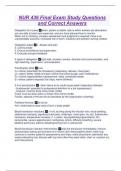NUR 436 Final Exam Study Questions
and Correct Answers
Delegation for nurses ✅when: patient is stable, task is within workers job description,
you are able to teach and supervise, and you have planned how to monitor
When not to: thinking, complex assessment and judgment is required; there is an
unpredictable outcome, increased risk of harm; creativity and problem solving needed
Delegation steps ✅1. Assess and plan
2. Communicate
3. Ensure surveillance and supervision
4. Evaluate and give feedback
5 rights of delegation ✅right task, situation, worker, direction and communication, and
right teaching, supervision, and evaluation
Prioritization skills ✅cure
C= critical: potentially life threatening (respiratory distress, chest pain)
U= urgent: safety needs and pain control (low blood surgar, pain medications)
R= routine responsibilities (assessment, vitals, scheduled meds)
E= extras: patient requests (ice chips, warm blankets)
5 fs of prioritization ✅- fatal: failure to do could cause death (respiratory distress)
- fundamental: essential to professional definition of a job (assessment)
- frequent: must be done many times (vitals)
Fixed: must be done within a certain time frame (meds)
Facility: aspects of the job set as standards by the organization (charting)
Parkland formula: ✅for burns
4ml x total body surface area of burn x body weight
Blood transfusion reactions ✅- n/v/d, burning along the infusion vein, facial swelling,
abdominal cramping, significant back pain, chills/rigor, chest pain, ha, dry, flushed skin,
hematuria, temperature increase >1 c, pallor, laryngeal/pharyngeal edema; htn,
tachycardia, severe apprehension, tachypnea, shock, difficulty breathing, severe
bilateral pulmonary edema, bleeding/oozing from iv site/wound
Blood transfusion reaction interventions ✅stop the transfusion immediately; remove
blood product tubing and connect ns to infuse; don't leave patient alone; notify hcp;
continue to monitor patient's assessments and vitals; notify blood bank; administer any
meds ordered by hcp; discuss with hcp how often they want vitals; chart vs, reaction s/s,
and interventions
, Sepsis recogntion ✅- surviving sepsis campaign: act quickly upon sepsis and septic
shock recognition, minimize time to treatment- sepsis and septic shock are medical
emergencies, monitor closely for response to interventions, communicate sepsis status
in hands-off
- hour 1 bundle: initial bundle upon recognition.
1. Measure lactate levels= remeasure if initial is elevated >2mmol/l
2. Obtain blood cultures before administering antibiotics
3. Administer blood cultures before administering broad spectrum antibiotics
4. Begin rapid administration of 30ml/kg crystalloid for hypotension or lactate > or equal
to 4mmol/l
5. Apply vasopressors if hypotensive during or after fluid resuscitation to maintain map >
or equal to 65
Common s/s of septic shock ✅fever, hypotensive, increased rr, decreased urine
output, crackles in lungs, increased wbc and lactic acid, tachycardia, lethargic, altered
loc, respiratory acidosis, o2 sat low, sob, clammy or sweaty skin
Dka priority assessment ✅assessment and initial actions:
- physical assessment with focused neuro and loc
- iv access and draw labs: cmp, cbc, abg, blood glucose, hemoglobin, a1c
- urine analysis and ketones
- assessment of the degree of dehydration: skin turgor, mucous membranes, % of
weight loss
- baseline ekg
- start with low dose insulin drip of 0.1units/kg/hr
- start fluid replacement per protocol
- hourly vs, blood glucose, and loc
- every 2 to 4 hours recheck labs and ketones
Neuro exam:
- cerebral edema: caused by osmolarity shift during rehydration and glucose
management; if cerebral edema is diagnosed, fluids should be reduced dramatically;
and mannitol infusions should be started; monitor q1hr
2 bag system for dka in peds ✅1. Insulin drip 0.1units/kg/hr
A. Insulin will lower blood sugar and stop ketone production= decreasing acidosis
B. Promotes cellular uptake of potassium, resulting in serum potassium deficit
C. Goals: slow the correction of blood glucose <100mg/dl per hour
2. Dextrose with the 2 bag system
A. 0.9% ns + d12 0.45% ns
3. Management of the system
A. Doctor must order a total fluid amount (1.5x maintenance fluid)
B. Start insulin drip
C. Blood sugar result is grouped into categories for amount of fluid given from each bag




